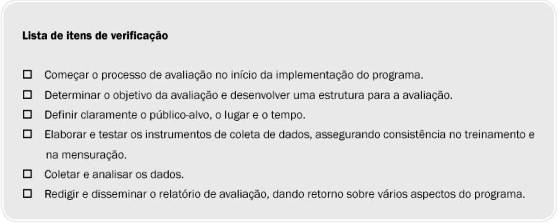Disseminação dos resultados da avaliação
Assim que uma avaliação estiver completa, é importante proporcionar feedback aos stakeholders envolvidos no programa. A disseminação dos resultados ajudará a reunir mais apoio para o programa se for bem sucedido, e ajudará outros a obterem apoio para a introdução de programas semelhantes. A publicidade das atividades de disseminação também pode aumentar o impacto do programa. Se o programa não tiver obtido sucesso, é importante compartilhar isso com outros para que os pontos fracos ou as questões relevantes sejam considerados em outras intervenções semelhantes, inclusive se devem ser introduzidas outras intervenções como essa.
A disseminação pode envolver a apresentação de resultados em reuniões públicas, usando- se a mídia para fazer propaganda dos resultados do programa, ou com a publicação de relatórios e trabalhos na literatura científica.
A utilização dos resultados da avaliação para dar retorno a um novo ciclo de planejamento
Considerar se a avaliação demonstrou algum benefício tangível – se o programa deve continuar, ou se precisa ser desmontado ou modificado? O programa existente pode ser melhorado com base na avaliação? Houve qualquer efeito colateral inesperado do programa? Os resultados da avaliação devem ser realimentados no ciclo de planejamento e as modificações apropriadas devem ser feitas no programa antes que seja estendido (Box 4.1).
Resumo
- A avaliação deve ser vista como componente de qualquer programa de uso de capacete. Uma avaliação precisa ser determinada no início do planejamento do programa, de tal forma que o plano para coleta de dados para esse propósito seja incluído na implementação do projeto. Além de proporcionar informação quanto à eficácia do programa, a avaliação ajudará a identificar se há qualquer problema na condução do problema.
- A determinação dos objetivos da avaliação ajudará a decidir como melhor realizar a avaliação. Há uma série de métodos que podem ser usados para avaliar um programa do uso de capacete. Cada método tem diversas vantagens e desvantagens, e a escolha de qual usar dependerá dos objetivos do programa de uso de capacetes e dos recursos disponíveis.
- É importante que os resultados da avaliação sejam compartilhados com as partes apropriadas, e que sejam usadas no planejamento do programa.
Referências
1 Rossi PH et al. Evaluation: a systematic approach. California, Sage Publications, 2004.
2 Britten N. Qualitative research: Qualitative interviews in medical research. British Medical Journal, 1995, 311:251–253.
3 Kitzinger J. Qualitative research: Introducing focus groups. British Medical Journal, 1995, 311:299–302.
4 Blantari J et al. An evaluation of the effectiveness of televised road safety messages in Ghana. International Journal of Injury Control & Safety Promotion, 2005, 12:23–29.
5 Hall M et al. Evaluation of a school-based peer leader bicycle helmet intervention. Injury Control and Safety Promotion, 2004, 11:165–174.
6 Parkin PC et al. Evaluation of a subsidy programme to increase bicycle helmet use by children of lowincome families. Pediatrics, 1995, 96(2 Pt 1):283–287.
7 Jackie Chan promotes helmet use in Cambodia (Press release, Phnom Penh, 25 April 2005). ( www. handicapinternational.be/downloads/Jackie_Chan_promotes_helmet_use.pdf ).
8 Woodward M. Epidemiology: study design and data analysis. 2nd edition. Chapman and Hall CRC, Boca Raton, 2005.
9 Rothman, KJ, Greenland S. Modern Epidemiology. 2nd ed. Hagerstown Maryland, Lippincott-Raven, 1998.
10 Thompson DC, Rivara FP, Thompson R. Helmets for preventing head and facial injuries in bicyclists. The Cochrane Database of Systematic Reviews, 2005 (4).
11 Liu B et al. Helmets for preventing injury in motorcycle riders. The Cochrane Database of Systematic Reviews, 2005 (4).
12 Drummond MF et al. Methods for the economic evaluation of health care programmes, Oxford, Oxford University Press, 1997.
13 Tan-Torres T et al, eds. WHO guide to cost-effectiveness analysis. Geneva, World Health Organization, 2003.
14 Kerry SM, Bland JM. Statistics notes: Sample size in cluster randomisation. British Medical Journal, 1998, 316:549.
15 Hatziandreu EI et al. The cost effectiveness of three programs to increase the use of bicycle helmets among children. Public Health Reports, 1995, 110:251–259.
Para ler mais, clique aqui
Para voltar ao início do manual ou para baixar o manual inteiro em formato pdf, clique aqui
 POR VIAS SEGURAS - Associação brasileira de prevenção dos acidentes de trânsito.
POR VIAS SEGURAS - Associação brasileira de prevenção dos acidentes de trânsito.

